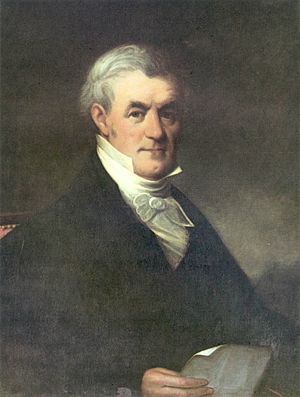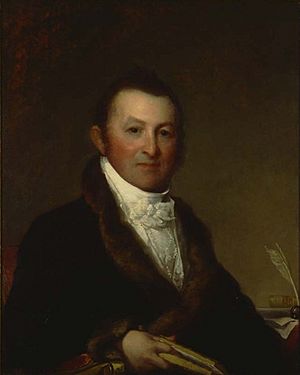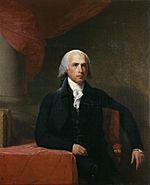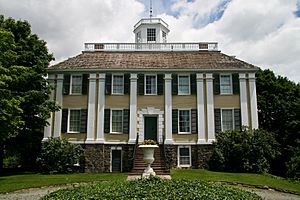William Eustis facts for kids
Quick facts for kids
William Eustis
|
|
|---|---|
 |
|
| 12th Governor of Massachusetts | |
| In office May 31, 1823 – February 6, 1825 |
|
| Lieutenant |
|
| Preceded by | John Brooks |
| Succeeded by | Marcus Morton (acting) |
| Member of the U.S. House of Representatives from Massachusetts's 13th district |
|
| In office August 21, 1820 – March 3, 1823 |
|
| Preceded by | Edward Dowse |
| Succeeded by | John Reed Jr. |
| In office March 4, 1801 – March 3, 1805 |
|
| Preceded by | Harrison Otis |
| Succeeded by | Josiah Quincy III |
| Constituency | 8th district (1801–03) 1st district (1803–05) |
| United States Envoy to the Netherlands | |
| In office July 20, 1815 – May 5, 1818 |
|
| President | James Madison James Monroe |
| Preceded by | William Vans Murray |
| Succeeded by | Alexander H. Everett (Acting) |
| 6th United States Secretary of War | |
| In office March 7, 1809 – January 13, 1813 |
|
| President | James Madison |
| Preceded by | Henry Dearborn |
| Succeeded by | John Armstrong Jr. |
| Personal details | |
| Born | June 10, 1753 Cambridge, Massachusetts Bay, British America |
| Died | February 6, 1825 (aged 71) Boston, Massachusetts, U.S. |
| Political party | Democratic-Republican |
| Spouse | Caroline Langdon |
| Education | Harvard University (BA) |
| Signature | |
| Military service | |
| Allegiance | |
| Branch/service | Continental Army |
| Years of service | 1775–1783 |
| Battles/wars | American Revolutionary War • Battles of Lexington and Concord • Battle of Bunker Hill • Siege of Boston • Shays' Rebellion |
William Eustis (born June 10, 1753 – died February 6, 1825) was an important American doctor and politician from Massachusetts. He trained as a doctor and served as a military surgeon during the American Revolutionary War. He was notably present at the Battle of Bunker Hill.
After the war, Eustis returned to his medical practice. However, he soon became involved in politics. He served several terms in the state legislature before being elected to the United States Congress in 1800. He was a moderate member of the Democratic-Republican Party.
In 1809, President James Madison chose Eustis to be his United States Secretary of War. This job involved managing the army. Due to his limited experience in this role and the army's lack of readiness, he was blamed for early military problems in the War of 1812. This led to his resignation.
President Madison then appointed Eustis as the United States Ambassador to the Netherlands. He held this position from 1814 to 1818. After another time in Congress, he was elected Governor of Massachusetts in 1822. He was a popular leader and died while in office in 1825. His historic home in Boston, the Shirley–Eustis House, is now a National Historic Landmark.
Contents
Early Life and Military Service
William Eustis was born on June 10, 1753, in Cambridge, Massachusetts. His father, Benjamin Eustis, was a well-known doctor in Boston. William was one of twelve children. He went to Boston Latin School and then to Harvard College, graduating in 1772. At Harvard, he was part of a student military group.
After college, he studied medicine with Dr. Joseph Warren, an important American leader. When the American Revolutionary War began in April 1775 with the Battles of Lexington and Concord, both Warren and Eustis helped treat wounded soldiers. Warren helped Eustis become a surgeon for the rebel army's artillery. Eustis cared for the injured at the Battle of Bunker Hill in June 1775, where Dr. Warren was killed.
Eustis served with the Continental Army in the New York and New Jersey campaign. He even turned down a higher military rank. During his time in the army, Eustis became good friends with Aaron Burr from New Jersey.
In 1777, Eustis was put in charge of a military hospital north of New York City. He stayed there for the rest of the war. In 1780, he was involved in a small way with the events surrounding the American traitor Benedict Arnold. Eustis treated Arnold's wife, Peggy, who seemed very upset after her husband's secret plan was discovered.
After the war, Eustis returned to being a doctor in Boston. He was called to serve again when Shays' Rebellion started in western Massachusetts in 1786. He became a surgeon for the militia force that stopped the rebellion in early 1787.
Political Career in Congress
Eustis was elected to the Massachusetts General Court (the state legislature) from 1788 to 1794. He then served on the Massachusetts Governor's Council for two years. In 1800, he ran for a seat in the United States House of Representatives. During his campaign, he was accused of being involved in letters from 1783 that suggested a possible uprising in the Continental Army. Eustis denied writing the letters, but later admitted he knew about the plan.
Eustis was a moderate Democratic-Republican. He did not support all the big changes that more radical Republicans wanted. For example, he voted against President Thomas Jefferson's plan to cancel a law that had added many federal judges. In 1802, Eustis was reelected. He lost his next election in 1804 by a very small number of votes. While in the House, he helped lead the first successful impeachment proceedings against a federal judge, John Pickering, in 1804.
Serving as Secretary of War
When James Madison became president in 1809, he wanted to strengthen the Democratic-Republican Party in New England. He chose Eustis to be his United States Secretary of War. Eustis was not the best choice for this job because he lacked strong management skills and deep military knowledge. He also had difficulties working with some senior army commanders.
Eustis tried to update the army's training manuals, which had not changed since the Revolutionary War. He had French military manuals translated and pushed for new ones based on French tactics. Even though a new manual was ready by 1812, army officers did not like it, and it was not used much during the war that began that year.
As tensions grew between the United States and Great Britain, Eustis made small efforts to prepare the military. However, he did not introduce major new plans. When the War of 1812 started, the army's supplies were disorganized, and there was no single overall commander. This meant Eustis had to make many detailed decisions for nine military regions.
When the war started badly, especially with General William Hull's surrender at Detroit, Eustis faced strong criticism. He resigned in December 1812.
Diplomat in the Netherlands
President Madison then appointed Eustis as the United States Ambassador to the Netherlands. He served in this role from 1814 to 1818. Madison believed this position was important for understanding what was happening in Europe. However, the Netherlands became less important after Napoleon's defeat, so the job was not very busy.
Eustis tried to get money from the Dutch government for American goods and ships that had been taken during the time Louis Bonaparte ruled the Kingdom of Holland. These claims were later recognized by France. In 1817, Eustis and Albert Gallatin, who was the US Ambassador to France, worked out a new trade agreement with the Dutch government. This agreement was approved in 1818. Eustis was at a disadvantage because he did not speak French well. He was called back to the US in 1818. While in Europe, Eustis reconnected with the Marquis de Lafayette, whom he had served with during the Revolutionary War.
Later Political Roles

After returning from Europe, Eustis bought a large house in Roxbury that had been built in the 1750s. This house is now known as the Shirley–Eustis House. Eustis was again elected to Congress in 1820 and served until 1823. He led the U.S. House Committee on Military Affairs. During the debate about admitting Missouri as a state, Eustis spoke strongly against a part of Missouri's proposed constitution that would have prevented free Black people from entering the state.
He ran for Governor of Massachusetts three times between 1820 and 1822, losing each time to the popular John Brooks. In 1823, Eustis finally won the governor's seat. He won against Harrison Gray Otis in a very close election. Republicans presented Eustis as a moderate leader and highlighted his experience in the Revolutionary War. Eustis's victory, along with Republicans winning control of the state legislature the next year, marked the end of the Federalist Party in Massachusetts.
Eustis was a popular governor and continued the moderate policies of his predecessor. He won reelection in 1824. While governor, he welcomed his old friend Lafayette when Lafayette toured the United States.
Eustis died in Boston from pneumonia on February 6, 1825, while still serving as governor. His funeral was held in Boston.
Personal Life
During the Revolutionary War, Eustis became very close friends with Aaron Burr. This friendship grew stronger in the 1790s.
For many years, Eustis was a bachelor, described as polite and charming. He married Caroline Langdon in 1801, and they did not have any children. Caroline was the sister of Henry Sherburne Langdon, who had married Eustis's sister Ann. Caroline's father was Woodbury Langdon, a well-known merchant and judge. Caroline lived forty years longer than William. After her death, his Boston property was divided among relatives. The mansion eventually fell into disrepair, but it was bought by preservationists in 1913 and restored. It is now a house museum and a National Historic Landmark.
Images for kids
See also
 In Spanish: William Eustis para niños
In Spanish: William Eustis para niños



